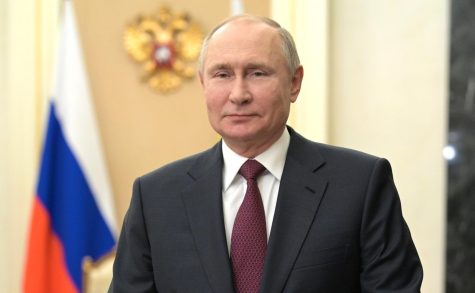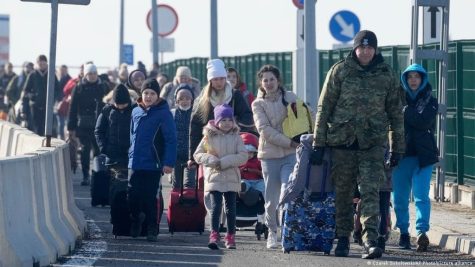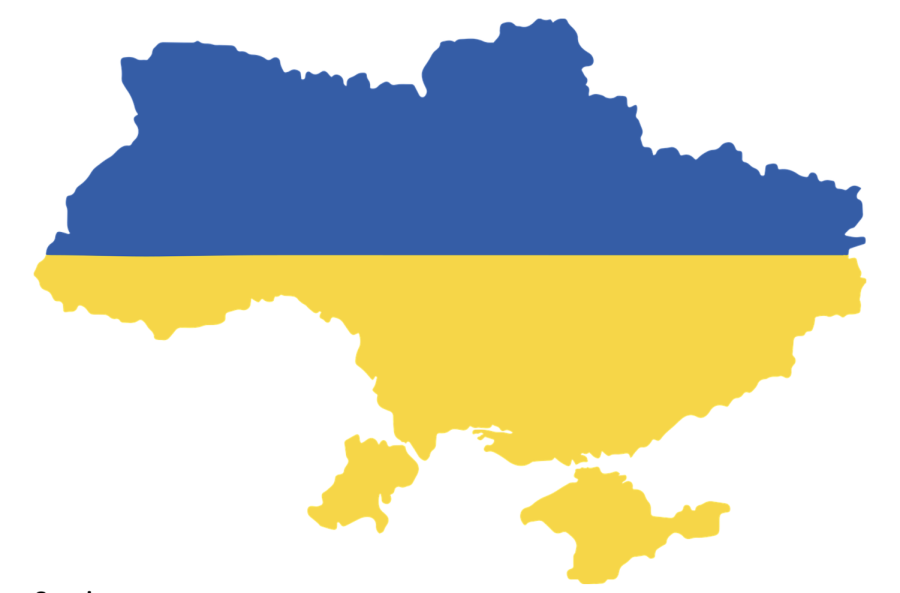When Will It End? – Russian Invasion in Ukraine
April 6, 2022
Overview
For nearly a month, Ukrainians have been facing an onslaught, as Russian troops continue to invade and diminish their country. Many cities now face the brute force of Russian soldiers, including the Ukrainian capital of Kyiv. Even prior to the war Vladimir Putin has asserted Russian dominance over Ukraine by seizing the Crimean Peninsula and backing separatists in the Donbas region of Ukraine. As the war escalated, Russian troops have been accused indiscriminately killing Ukrainian civilians and causing the displacement of millions. Ukrainian officials blame Russia for the bombing of an art school serving as shelter for around 400 people and a theater sheltering possibly up to 1,300 (Carey, Voitovych, and Kesaieva, 2022). Moreover, The World Health Organization has confirmed 64 attacks on health care centers in the country as of March 22, 2022. The invasion has been condemned internationally, with leaders from 141 nations expressing their demands of withdrawal in the UN General Assembly (Borger, 2022). Nevertheless, no progress has been made, as Ukrainians continue to fight for the sovereignty of their country.
Historical Context

As WW2 came to an end, the countries of Europe have been marked under the spheres of political influence of the United States and the Soviet Union (USSR). The Soviet Union expanded its control to Eastern European countries by establishing satellite states, where they installed communist leaders and governments. In contrast, Western Europe developed democracies and capitalist economies with the support of the US. These spheres of influences soon transformed into military alliances. By 1949, the North Atlantic Treaty Organization (NATO) was formed, consisting of ten Western European countries, the US, and Canada, which sought to protect one another from soviet aggression and invasion. The USSR and seven Eastern European countries followed suit, organizing the Warsaw Pact to balance power.
The ideological divide between the two continued to fuel tensions throughout the Cold War. Europe remained this way for decades until the Warsaw Pact began unravelling. Eventually, the USSR collapsed in December of 1991, allowing republics such as Ukraine to declare independence from the Soviets. The Soviet sphere of influence faded, as many newly established countries overthrew communist governments. Still, the NATO alliance remained, partnering with Ukraine in 1994 (not formal membership) and expanding into former Warsaw Pact countries (Poland, Hungary, Czech Republic) in 1999. Further pushing into the old Soviet sphere of influence, in 2004 NATO integrated seven more countries. By this point, there were only three former Soviet republics (Ukraine, Georgia, Belarus) separating Russia from NATO states. The Russian government has long considered eastward NATO expansion as a danger to Russian sovereignty.
Although gaining independence, Ukraine remained heavily tied to Russia, both economically and politically. In 2013, an agreement between Ukraine and the European Union (economic institution of mainly Western European states) fell apart due to the pro-Russian Ukrainian president, Victor Yanukovych. Yanukovych instead chose to strengthen ties with Russia and the Eurasian Economic Union (economic institution of post-Soviet republics). Many Ukrainians felt that they were being “sold out” to Russia, and protests (known as Euromaidan) ensued demanding the original agreement to be signed. Citizens accused Yanukovych of corruption, violation of human rights through police brutality, and oppression. Soon after these protests, the “Revolution of Dignity” erupted, in which Yanukovych was overthrown and Ukrainian Parliament voted unanimously to oust him from the presidency (White, 2014). For Vladimir Putin (Russian President), this had meant Russia lost its political influence over Ukraine. This realization promptly resulted in the overtaking of various eastern and southern regions in Ukraine populated by ethnic Russians. Under the ruse of protecting ethnic Russians, Putin began occupying and later annexing Crimea, a strategic Ukrainian Peninsula. Furthermore, Russian-backed separatist groups successfully captured the Donetsk and Luhansk regions of Ukraine, provoking the war in the Donbas region. Russia continued to exert control over these regions with the intent of destabilizing Ukraine to prevent the nation from incorporation into the West.
Immediate cause

In November of 2021, satellite images found over 100,000 Russian troops and military equipment accumulating alongside Ukraine’s border. The Russian president denied any plans, but weeks later voiced his demand that NATO should cease its expansion by returning to their borders in 1997 and deny Ukraine NATO membership (Meyer and Arkhipov, 2021). Western leaders quickly dismissed Russia’s demands as excessive and unrealistic, and instead reinforced military presence across NATO states in eastern Europe. By February 21st the following year, Russian troops crossed Ukraine’s border into regions controlled by pro-Russian separatists, under the pretense of peacekeeping. The current Ukrainian president, Volodymyr Zelensky announced a state of emergency immediately. Three days later, Putin launched a full-scale invasion into Ukraine, with the goal of replacing the current Ukrainian leadership with a pro-Russian puppet government.

Humanitarian Crisis

As the war escalates rapidly, millions of civilians are displaced, thousands are killed, and even more are injured. The refugee crisis in Ukraine is one of the worst the world has seen, as 6.48 million are displaced within the country and over 3.5 million have fled to neighboring countries. The numbers are expected to grow tremendously. Furthermore, Ukrainians remain in dire need of emergency and medical aid. Medical services are isolated since they are either destroyed or are lacking personnel. Lack of access to food, water, and electricity is a growing issue for many Ukrainians, as they are trapped in the center of the conflict.
Response
The invasion has garnered world-wide attention and support for Ukraine, as anti-war protests emerge ubiquitously. Contrary to popular belief, a considerable number of Russians do not support their governments invasion into Ukraine. Despite facing police brutality, many citizens have taken to the streets of St. Petersburg and other cities to express their discontent with the actions of their government. Shockingly, OVD-Info places the estimate of apprehended Russian protesters at 13,000 since the start of the invasion (Gittins, 2022). Another notable even of Russian solidarity with Ukrainians includes Channel One editor, Marina Ovsyannikova, interrupting a news broadcast by calling out to end the war and holding up a poster portraying anti-war sentiment. Agora (Russian human rights group) announced that Ovsyannikova was arrested quickly after and later taken to Moscow’s police station (Sauer, 2022). Many businesses, entertainment channels, and sports industries have also pitched in by boycotting Russia.
On a political level, World leaders have condemned the war and sought to reason with Russia throughout the duration of the invasion. Harsh new sanctions have been imposed, attempting to halt Putin’s progression by creating a financial crisis in Russia. Conversely, Ukraine has been flooded with military, economic, and humanitarian aid and its refugees are welcomed in many surrounding nations.
Effect on the World
United States
Many economic issues have accumulated in the United States as the Russian invasion continues. Most notably, affecting Americans nationwide is gas prices, which have skyrocketed from the previous year. Despite the U.S importing minimal amounts of Russian oil, the sanctions placed on Russia have disrupted the global oil market, causing massive effects in America. The national average price of gas was about $2.71 per gallon, compared to the current $4.33 per gallon. Moreover, the energy cost is rapidly increasing, and oil prices have reached $100 a barrel for the first time in almost a decade. The intense economic problems will continue to afflict low-income Americans.
Europe
European nations’ proximity and reliance on one another have produced imminent threats to security and the economy. As the war drags on, millions of refugees spill into Poland, Romania, and other neighboring countries from Ukraine, despite the inability of some to accommodate them and the strain it places on the economy. Also, dependency on Russian natural gases from numerous nations in Europe will prove menacing as these countries frantically attempt to halt Putin’s expansion in Ukraine. However, the more pressing issue is the possibility of wider war. If Putin’s war in Ukraine falls into surrounding NATO countries, all members of NATO will have direct military conflict with Russia. These European nations remain on edge because Putin controls the world’s largest arsenal of nuclear weapons. Engaging in nuclear war would result in devastating consequences, for Europe and the rest of the world.
Middle East
The dependency of the Middle East on food resources from Ukraine and Russia has posed a major threat to the region with the ongoing war. Many nations in the area are already faced with massive food shortages and copious amounts of people facing hunger, which is only expected to get worse. Ukraine and Russia, which share the title of Europe’s Breadbasket, are among the world’s largest wheat producers, and Middle Eastern nations are the biggest consumers. Countries, such as Egypt, which gather 85% of wheat imports from Ukraine and Russia (Hamzawy, 2022), or Lebanon, where 80% of wheat is from Ukraine alone (Human Rights Watch, 2022) face imminent threats of widespread hunger. The rising prices of wheat items potentially yield adverse effects on stability and living standards in the region.
World as a Whole
The sanctions placed on Russia have been stifling global trade, resulting in the increased costs of international goods and the distortion of the supply chain. Furthermore, the dependency on Russia and Ukraine for natural resources, food items, and oil has posed major issues for both developed and underdeveloped countries. Millions of people will continue to be negatively affected as global food supply and trade persistently declines.
Closing
As of now, it seems that the war is not coming to an end anytime soon. Donations to UNICEF, Ukrainian Red Cross, UNHCR, International Medical Corps, and many more certified organizations have aided hundreds of millions in the Ukrainian relief effort by supporting innocent civilians. World leaders will continue to reason and negotiate with Moscow, in the hopes of halting the invasion and resolving the conflict.

